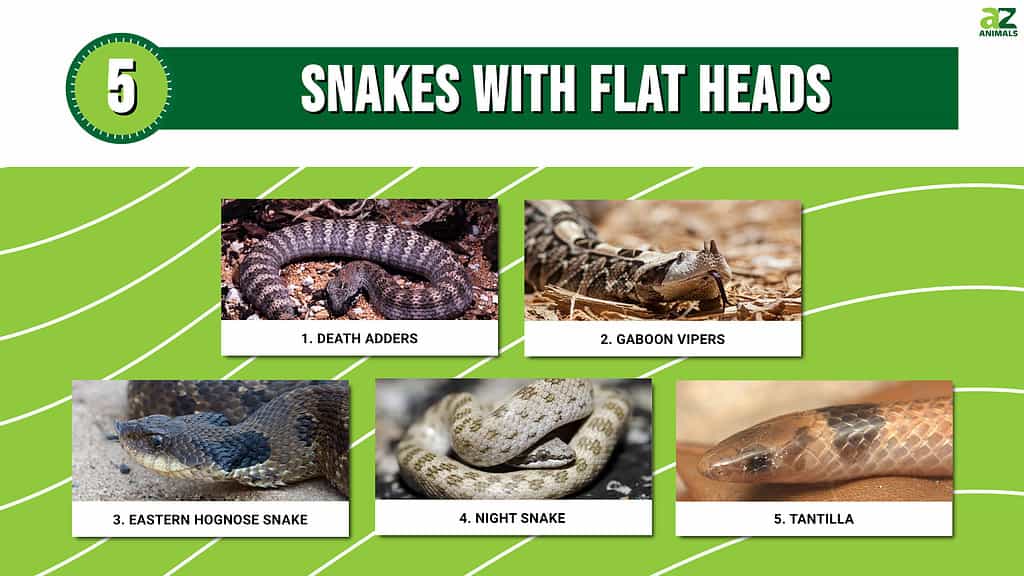
A snake’s head can tell you quite a lot about its species and venom. Not only do snakes have varying head shapes, but their features, such as eyes, teeth, and even saliva, are unique to their species. Their features are usually a result of adaptation due to evolution.
When snakes first appeared about 128 million years ago, they lived in warm and forested ecosystems and were nocturnal hunters. As time passed and the ecosystem changed, snakes, like all animals, needed to adapt to survive.
This article takes a look at 5 snakes with flat heads, their features, and all you need to know about them. Let’s get started.
1. Death Adders (Acanthophis antarcticus)
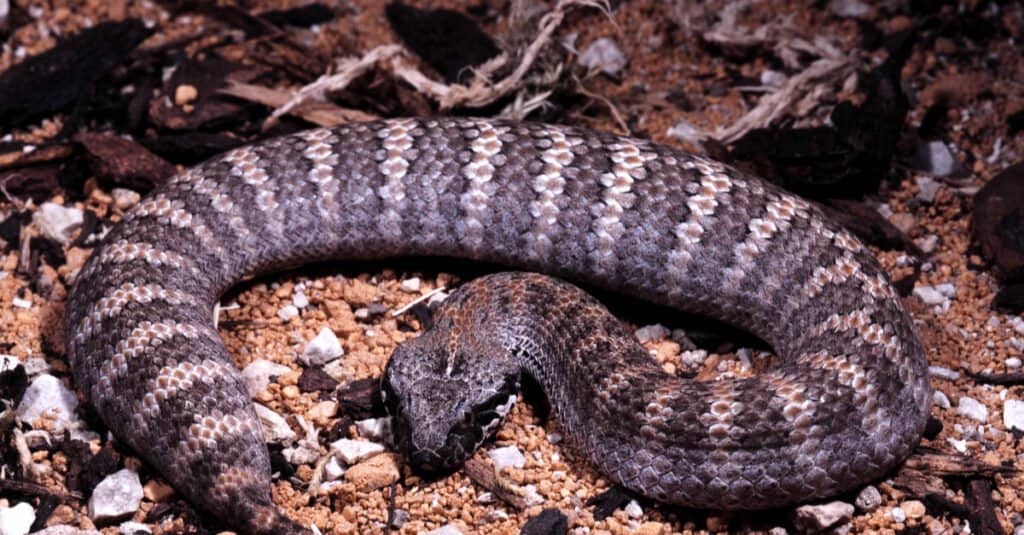
The common death adder is a common Australian venomous snake.
©Vladislav T. Jirousek/Shutterstock.com
Death adders are extremely venomous elapids known for their quick bites. They have the longest fangs of any snake species native to Australia. According to the Integrated Taxonomic Information System, there are two subspecies of common death adders – Acanthophis antarcticus antarcticus and Acanthophis antarcticus schistos.
Death adders are heavy snakes with flat and triangular heads. Despite their toxic venom, these snakes are not aggressive and usually strike when they have no other option, preferring to hide and camouflage. Their bodies are made of brown, black, and red bands, while their bellies are pink, cream, or grey. On average, they measure from 27.6 to 38 inches long.
2. Gaboon Vipers (Bitis gabonica)
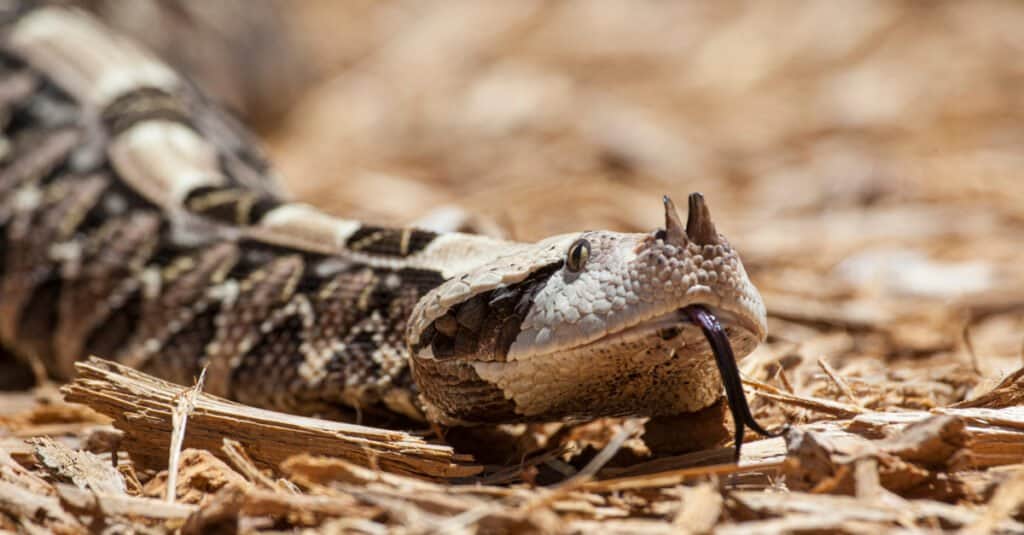
Gaboon vipers have flat heads, which give their long fangs room to fold in.
©Danita Delimont/Shutterstock.com
Gaboon vipers are one of the largest vipers in Africa, measuring around 4 to 7 feet long. These snakes are extremely venomous and yield very high amounts of venom. Gaboon vipers can kill a human with only 14mg of venom and produce up to 600mg of venom, making them strong enough to kill 40 humans.
Gaboon vipers have flat heads. Their head shapes allow them to blend in and also fold in their really long fangs as they have some of the longest fangs of any snake. Their solenoglyphous fangs allow them to inject their heavily toxic venom deep into their victims.
3. Eastern Hognose Snake (Heterodon platyrhinos)
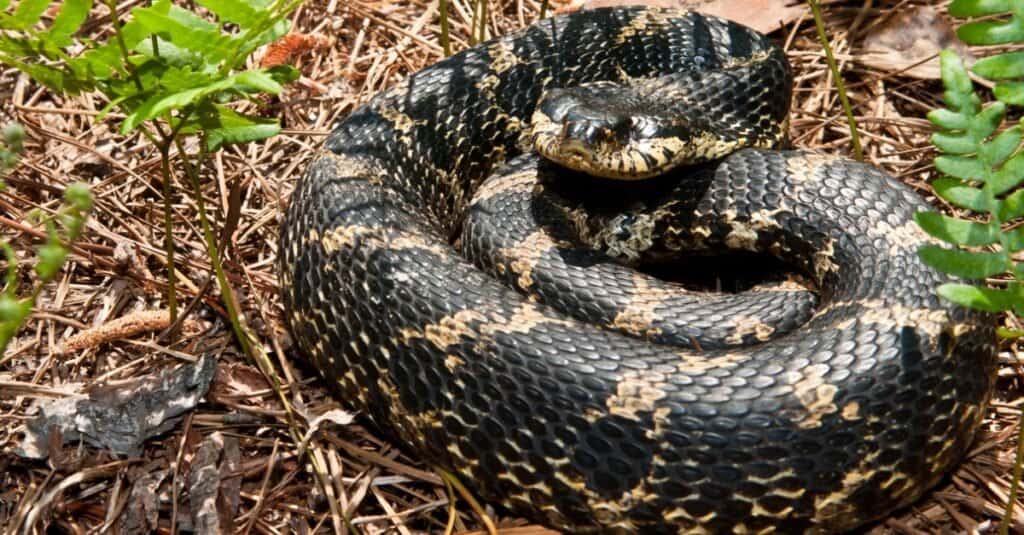
Eastern hognose snakes can easily be recognized by their flat heads and snouts.
©iStock.com/JasonOndreicka
Eastern hognose snakes are one of the best snakes to keep as pets. As you might imagine, they are nonvenomous and aren’t usually lengthy. On average, they measure 28 inches but have been known to attain up to 46 inches. These snakes are one of the most popular flathead species and are sometimes called flathead adders.
Eastern hognose snakes come in many colors, including brown, gray, and orange, and are even known to sometimes have all three colors. Apart from their heads, one major distinctive feature is their nose. Hognose snakes have some of the weirdest noses or snouts ever. These snakes use their upturned snouts to dig up the soil, and when they are threatened, they flatten their necks and raise their flat heads and snouts off the ground.
Hognose snakes are also known to go completely limp in an attempt to play dead. Sometimes, they even leave their mouths open and let their tongues dangle. Talk about dramatic! They are known to play dead for up to 45 minutes, and when they get bored or feel that the threat has passed, they wake and slither away. These snakes can bite but only do when they are threatened. They are also known to spray musk to protect themselves from attackers.
4. Night Snake (Hypsiglena torquate)
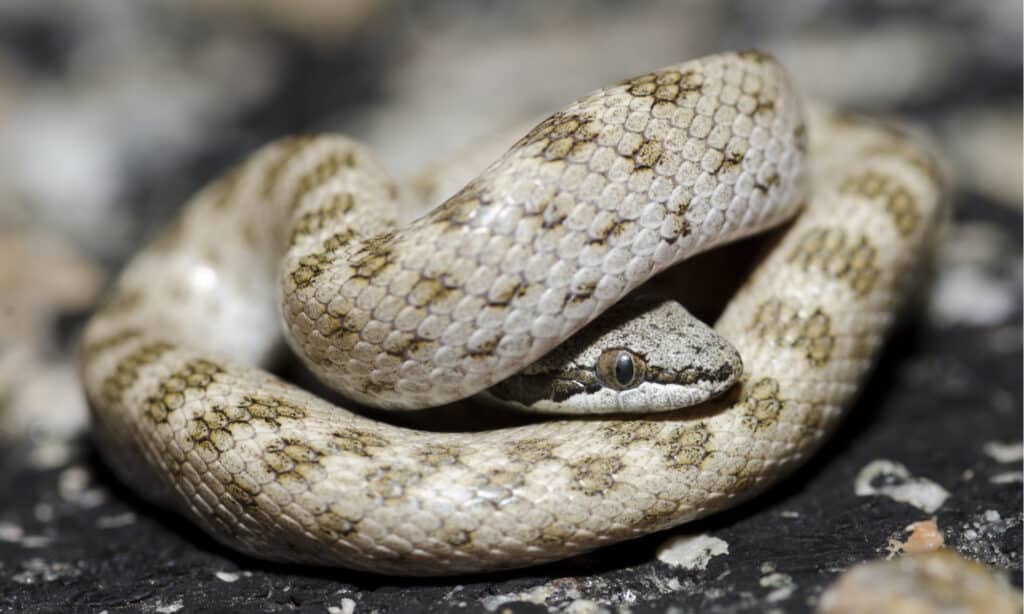
Night snakes are flat-headed and nonvenomous but are often mistaken for rattlesnakes.
©Jason Mintzer/Shutterstock.com
Night snakes are rear-fanged rattlesnake-lookalikes. If you’re wondering how that is possible because rattlesnakes have prominently non-flat, triangular heads, we’ll explain. Night snakes have narrow snouts which gradually widen, giving their heads a triangular shape. However, close inspection clearly reveals that their heads are indeed flat. A snake can have a triangular and flat head.
Night snakes have venomous saliva, which means that they do not inject their venom only via their rear fangs but also through their saliva. However, their venom is quite weak and only potent to lizards, mice, and other small animals they prey on. They use their venom to weaken and digest their prey.
As their name implies, these snakes are nocturnal and commonly found in rocky outcrops and crevices when the weather isn’t so cool. They are also commonly spotted in arid desert scrub habitats. Night snakes may be spotted at dawn, dusk, and sometimes, late afternoons in cool weather.
5. Tantilla (Tantilla)

Tantilla refers to a genus of about 65 snakes, otherwise known as flathead snakes or
centipede
snakes.
©Heather PaulFollow / flickr – License
Unlike other snakes listed here, the Tantilla doesn’t refer to a single snake species but to a whole genus, otherwise known as flathead snakes or centipede snakes. Snakes under this genus are all harmless but not non-venomous. This means that some species have venom, but just like the night snake and many other colubrid snakes, they are only dangerous to their prey.
The genus includes 65 species of snakes that rarely exceed 20 cm (8 inches). It is important to remember that, although they are regarded as harmless, bites from them should still be treated as an emergency.
What Can A Snake’s Head Tell You About It?
Here are some things you can learn about a snake from its head:
Shape
Most venomous snakes have triangular heads, while nonvenomous snakes usually have rounded ones. The shape of a snake’s head is instrumental in deterring predators. As we’ve explained, snakes sometimes flatten their heads to look frightening, and some snakes make their heads appear triangular, so they seem more venomous.
Pits
Some snakes have pit organs on each side of their heads, between each nostril and eye. Pit organs give snakes the ability to see infrared rays. All living beings emit a level of heat or infrared rays that are not visible to the human eyes. However, snakes with pits can see these rays, so they detect other animals’ presence and movements.
Eyes
Most venomous snakes have slit pupils (called elliptical pupils), while nonvenomous snakes have round ones. Nocturnal snakes also have slit pupils, while diurnal snakes usually have round ones. Usually, snakes have yellow eyes but can also have other eye colors such as red, grey, and even blue.
Teeth
Almost all snakes have 6 rows (rows and not individual teeth) of teeth; 4 at the bottom and 2 at the top. These teeth are usually small and sharp. However, only venomous snakes have fangs. Simply looking into a snake’s mouth can tell you whether or not it is venomous and even give you a hint of its species. Vipers have solenoglyphous fangs, colubrids have opisthoglyphous fangs, and elapids have proteroglyphous fangs.
Summary of 5 Snakes with Flat Heads
| # | Snake | Danger Level |
|---|---|---|
| 1 | Death Adder | Extremely venomous |
| 2 | Gaboon Viper | Extremely venomous |
| 3 | Eastern Hognose | Nonvenomous |
| 4 | Night Snake | Weak venom |
| 5 | Some venom |
The photo featured at the top of this post is © iStock.com/Ken Griffiths
Discover the "Monster" Snake 5X Bigger than an Anaconda
Every day A-Z Animals sends out some of the most incredible facts in the world from our free newsletter. Want to discover the 10 most beautiful snakes in the world, a "snake island" where you're never more than 3 feet from danger, or a "monster" snake 5X larger than an anaconda? Then sign up right now and you'll start receiving our daily newsletter absolutely free.
Thank you for reading! Have some feedback for us? Contact the AZ Animals editorial team.






